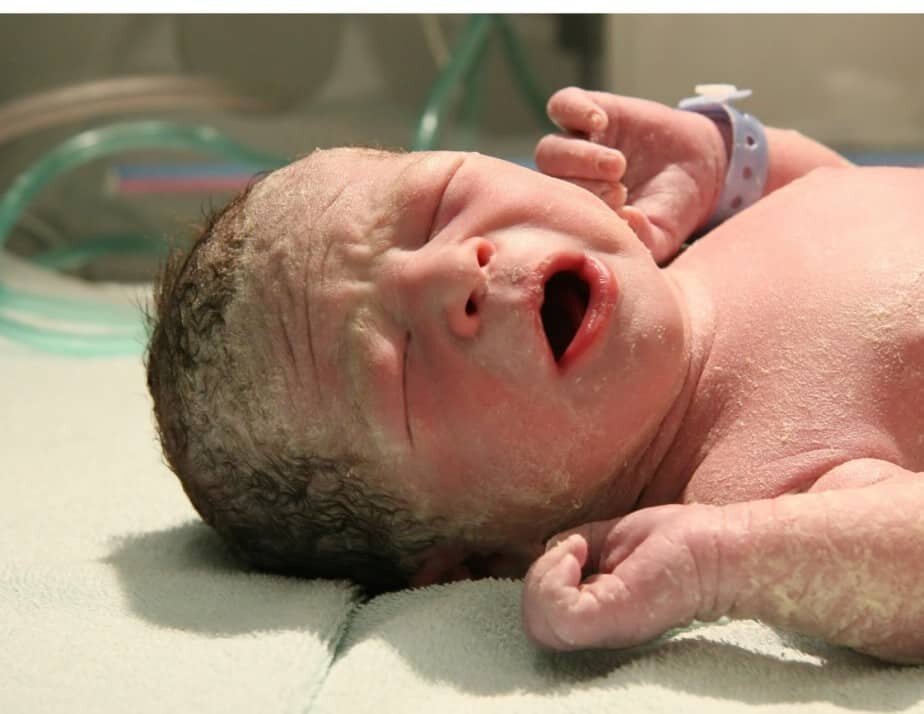Many babies are born every year who don’t cry nor breathe right after birth. This situation results in the need for reviving or resuscitation measures to be initiated immediately to save those babies. It is estimated that 4%-10% of all term and late-term newborns receive positive ventilation (=external artificial breaths) after birth due to their inadequate or lacking breathing efforts.
Often parents and families ask the question: “what are the causes for a baby to be born not breathing or inadequately breathing?”
In short, babies may be born without spontaneous respiratory effort due to factors related to the delivery process, maternal health issues, and the baby’s medical conditions.
This article will discuss in more detail factors associated with or leading to outcomes where the baby does not initiate its breathing after birth. In another article, I explained how we treat those babies.
In what situations a baby may have problems with breathing after birth?
Below, I will describe three categories of conditions associated with babies potentially having breathing problems after birth. Please note that these are only associations, meaning that they increase the likelihood of the problem. Not all cases with a particular diagnosis will result in the baby having breathing problems after birth.
The baby’s health conditions
Even if pregnancy and delivery process were uneventful, certain conditions originating in a baby may make it vulnerable to develop breathing problems soon after birth.
Multiple gestations
Multiple gestations (twins, triplets, etc.) increase the likelihood of premature delivery and complicated birth process. Both prematurity and prolonged delivery are associated with a higher risk of breathing problems after birth.
Fetal anemia
Fetal anemia (anemia before birth) may occur due to infections, chronic bleeding, blood group incompatibility, or blood loss around birth time. Regardless of the cause, severe anemia may be associated with breathing problems after birth.
Congenital neurological defects
The nervous system (brain and nerves) is responsible for giving us stimulation to breathe and inducing breathing muscles to contract and do their job moving the chest. Babies with congenital or acquired brain disorders may have a problem with breathing; some of them may need to be placed on a ventilator after birth.
Genetic defects
Many genetic disorders are associated with abnormalities in the muscles, the central nervous system, or the respiratory system. Breathing and oxygenation in our bodies is a function of all these three parts working well together.
Congenital defects of the respiratory system
Some babies are born with congenital defects in the respiratory system. Those are anatomical abnormalities due to genetic or environmental influences. Examples of these conditions are birth with a single lung, various chest tumors, or blocked airway. Many congenital diseases of the respiratory system will result in a baby needing oxygen after birth or placement on a ventilator.
Severe infections (chorioamnionitis)
Severe infections in the mother may lead to serious infections of their fetus, affecting its brain, heart, and lung functions.
Prematurity
Prematurity is defined as birth before completed 37 weeks of gestational age. Any degree of prematurity increases the risks of breathing problems in the baby. However, babies born before 28 weeks are almost guaranteed to have breathing problems requiring oxygen therapy. Also, many of these babies will need a ventilator in their first few days of life. You can find more information about premature babies from my book “Babies Born Early”
Small baby
Small babies are usually premature as well, but not always. If the baby is tiny, naturally, the lungs will be little and often underdeveloped, and respiratory muscles may be very weak. Babies born with birth weights of less than 1000 grams (2.2 lbs ) are likely to have breathing problems after birth and even require a ventilator during the first few days of life.
Maternal medical issues
A growing fetus needs a mother for its development. The mother is providing all nutrients and oxygen required for her baby’s health. No surprise then that many maternal conditions and necessary treatments will affect the baby as well.
Cesarean section under general anesthesia
Spinal anesthesia is a preferred method for pain management in a woman who undergoes cesarean delivery because it is better for mothers and babies. Sometimes, due to technical difficulties or in an emergency, general anesthesia is required. During general anesthesia mother is given sleeping and pain medications, which may have similar effects on a baby, making the baby sleepy and not wanting to breathe after birth.
Drug abuse
If a mother delivering a baby is under heavy influence of illicit opioid drugs, the baby will be born severely sedated and will need help with breathing.
Maternal hypertension treated with magnesium
Many pregnant women suffer from high blood pressure or preeclampsia. When hypertension is severe, we have to treat it with medications. One of the most popular drugs to treat hypertension in laboring mothers is magnesium sulfate. Unfortunately, sometimes this treatment results in babies being born with decreased muscle tone, having a slower respiratory rate, or even presenting with apnea (Apnea is defined as a pause in respiratory effort). Some babies will require stimulation and positive pressure ventilation in the delivery room and later oxygen therapy in the nursery. The good news is that magnesium leaves our system with urine. Therefore, within 24-48 hours, the baby’s magnesium levels will get back down to normal, and the baby will not be affected anymore.
Any organ failure in a mother
In general, any severe health condition in a mother that influences oxygen levels, blood pressure, nutrients, and metabolic homeostasis, may also adversely affect the baby. Examples of such conditions are epilepsy, heart failure, severe high blood pressure, pneumonia, kidney failure, and many others.
Situations during labor (delivery process)
Labor is a challenging and complicated process. When things are out of the ordinary or complications occur, there is more chance for the baby’s well being to be compromised.
Prolapsed umbilical cord
When a baby is in the mother’s uterus, it receives all the nutrients and oxygen from the mother via umbilical cord. The umbilical cord has three blood vessels connecting the baby with its mother’s placenta. Occasionally, during labor, particularly in situations where the umbilical cord is long, it may drop out of the uterus into the vagina. When that happens, the umbilical cord gets compressed by the baby’s head, and the baby’s blood supply will decrease or stop almost completely. Prolapsed umbilical cord constitutes an obstetric emergency and should result in most cases in urgent cesarean delivery.
Placental abruption
Placenta is an organ responsible for delivering oxygen and nutrients from the mother to the baby through the umbilical cord. In rare instances, when the placenta separates partially or entirely from the uterus, it may compromise the baby’s blood, nutrient, and oxygen supply. Decisions on how to deliver the baby will depend on the abruption’s size and the baby’s well-being.
Breech delivery
Most babies are born with the head coming out of the birth canal first. Sometimes baby’s butt is first, and that may result in challenges and difficulties. For that reason, nowadays, many breech positioned babies are being born by planned cesarean section to avoid those difficulties. However, one should know that a breech position is not an absolute contraindication to vaginal delivery.
Abnormal fetal presentation
Other fetal presentations may lead to difficult or prolonged vaginal delivery in addition to breech position. Examples of those are a transverse lie, face presentation, and hand or leg presentation.
Uterine rupture
A rupture of the uterus during labor may occur for many reasons. The most commonly known association is having one or more cesarean sections in the past. The uterine rupture leads to acute loss of a large amount of blood by the mother and usually leads to severe deterioration of the fetus’s well-being and maternal health. If not treated immediately, it may result in the death of both mother and baby. The treatment often involves an immediate cesarean section, controlling uterine bleeding, and blood transfusion for the mother.
Meconium stained amniotic fluid
When a baby passes bowel movement in utero, and it mixes with amniotic fluid, we call it “meconium-stained amniotic fluid.” The baby may swallow this fluid and aspirate it into its lungs, leading to compromised respiratory efforts after birth. I wrote a separate article about this condition, and you can read it here.
Long labor process
During the labor process, the uterine contracts frequently, resulting in transient blood flow decreases to the baby. However, in most cases, it is normal, and the baby can tolerate it very well. When the labor process is unusually prolonged with frequent and intense contractions, it may lead to lower oxygen levels and higher acid production in the fetus and baby, affecting its well-being right after birth. Unfortunately, it is not easy to determine what exactly constitutes abnormally prolonged labor. Doctors have to monitor various fetal well-being indicators to decide when to intervene and proceed with cesarean delivery.
Shoulder dystocia
Shoulder dystocia is a condition that may occur in the final stage of the birth process. Due to positioning or disproportion between the birth canal’s size and the baby, after the baby’s head is delivered, it is tough for the rest of the baby’s body to come out from the birth canal. Lay people often say that “baby got stuck.” Fortunately, with vigorous use of specific maneuvering and repositioning of the mother and baby, obstetricians can deliver the baby. However, it may take a long time during which the baby gets negatively affected and will have problems initiating respirations after birth.
Can we predict that baby will not breathe right after birth?
Whenever a baby does not breathe or cry right after birth, it is scary for the parents and families. It would be nice to be able to predict which babies may do that. We can’t do that with absolute certainty but certain information may help us predict that baby is likely to require some reviving after birth.
The three methods that we utilize to monitor the fetus’s well-being during labor are fetal heart rate monitoring, scalp pH sampling, and ultrasound.
The fetal heart rate monitoring can be conducted using external leads located on the mother’s abdomen or internal electrodes (scalp monitoring) attached to the baby’s scalp palpable through the mother’s birth canal (after membranes have ruptured). Observing the baby’s heart rate patterns allows us to decide how well the baby is tolerating labor and whether to intervene with a speedier delivery method such as cesarean section.
Scalp pH sampling relies on obtaining a drop of blood from the baby’s scalp before delivery to evaluate pH. The “pH” value is an indicator of acid-base balance in the baby. Whenever the baby has too much acid, it is a sign of trouble and, at certain values, prompts us to perform an urgent cesarean section to deliver baby without further delay.
Evaluation of the baby by ultrasound is not conducted that often during labor. However, it may be beneficial in diagnosing placental abruption or uterine rupture. The downside of doing ultrasound is that it takes time and may delay making important decisions. When in doubt, obstetricians rather err on the side of doing urgent cesarean section rather than postponing it and performing an ultrasound to diagnose uterine rupture or something else. Remember that uterine rupture or placental abruption may have grave consequences. As with everything in medicine, there is always a trade-off. We, as physicians, should inform patients and families about the benefits and risks of each approach.
Babies who are born with breathing problems will need resuscitation. You can learn about those measures from my article linked above or from this scientific resource available here.
Disclaimer:
This article is only for general information purposes. It should not be viewed as any medical advice. There is a chance that information here may be inaccurate. It would be best if you always discussed all health-related matters with your doctor before making any decisions that may affect yours or your family members’ health.

